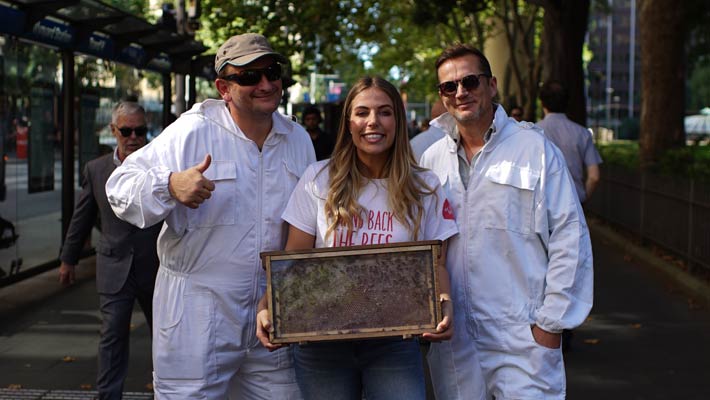What's all the buzz about?
Bees are nature’s superheroes and have played a vital role in our ecosystem since the dawn of time. In fact, one third of all the food we eat is thanks to pollinators like the bees – many of our favourite fruit and vegetables would simply disappear without them.
There are over 20,000 known bee species pollinating our world, with over 1600 species of native bees right here in Australia. The Honeybee is undoubtedly the most important and hardworking of all bees, supporting our environment in many secret ways.
As social animals, Honeybees live in a complex society with a beehive usually housing around 40,000 bees! Inside the beehive each bee has a special job to do so the whole process runs smoothly; with a queen, security guards, builders and repairers, cleaners, nurses, undertakers, heating and cooling technicians, scouts, honey makers, pollen stampers, store workers and collectors of nectar, pollen and water. During its lifetime, each worker bee performs a number of these different tasks, and with great dedication.
Worker bees start out from the hive for blossom patches when they are only three weeks old. As they live to be only six or seven weeks old, they have much work to do and little time in which to do it. It takes 768 bees visiting approximately 2 million flowers, over 88,514 kilometres to produce 450 grams of honey.
Learning about the secret life of bees goes beyond the sweet taste of honey. These winged creatures are arguably the most important animal on our planet and we humans need to change some BEE-haviours to ensure their survival well into the future.
A Partnership never tasted so sweet!
Taronga Conservation Society Australia has had a successful partnership with Burt’s Bees since 2016. Burt’s Bees is a Champion Sponsor of the Taronga Foundation and has been instrumental in helping us to share stories with our visitors about the secret life of bees.
Taronga and Burt’s Bees worked together to create a bespoke bee ‘observational hive’ installation in-grounds at our Backyard to Bush precinct. The exhibit aims to educate guests about bee conservation and the importance of bees to the environment.
More recently, Taronga teamed up with Burt’s Bees on its ‘Bring Back the Bees’ campaign. The purpose of the campaign is to raise awareness around the declining bee populations all over the world which could have catastrophic impacts for the environment and wildlife in the future if not curbed.
Taronga Zoo’s resident bee expert Elle Bombonato has played a major role in the campaign, providing insights about bees and their critical role in our ecosystem, while showcasing the hives we have on site here at Taronga.
As part of the ‘Bring Back the Bees’ campaign, Taronga Zoo Sydney is selling beautiful Burt’s Bees lip balms through its retail store (including the limited edition strawberry lip balm and the Taronga x Burt’s Bees co-branded balm) with Burt’s Bees contributing proceeds from all sales of the balms to assist with vital research into helping defend the species.

Bee part of the change at home:
- Lose the pesticides and nasty garden sprays. Ladybugs, spiders, and praying mantises will naturally keep pest populations in check.
- Plant! Plant! Plant! Bees are having a difficult time trying to find food sources. More lawn, more cement, more sprays and pesticides mean a decline in flowers and pollinator plants. It is literally becoming like a desert out there for our busy bees. Just one flowering plant can change the landscape for bees.
- Do you have limited space or no garden at home? You need only a small plot of land—it can even be a window container, vertical garden or rooftop—to create an inviting oasis for bees. Every little bit can help to nurture bees and other pollinators.
- Create a ‘bee bath.’ Bees need a place to get fresh, clean water. Fill a shallow container of water with pebbles or twigs for the bees to land on while drinking. Make sure to maintain the container full of fresh water to ensure they know they can return to the same spot every day.
- Support bees, beekeepers and our local farmers by buying local honey.
BEE WILD. FOR THE WILD.